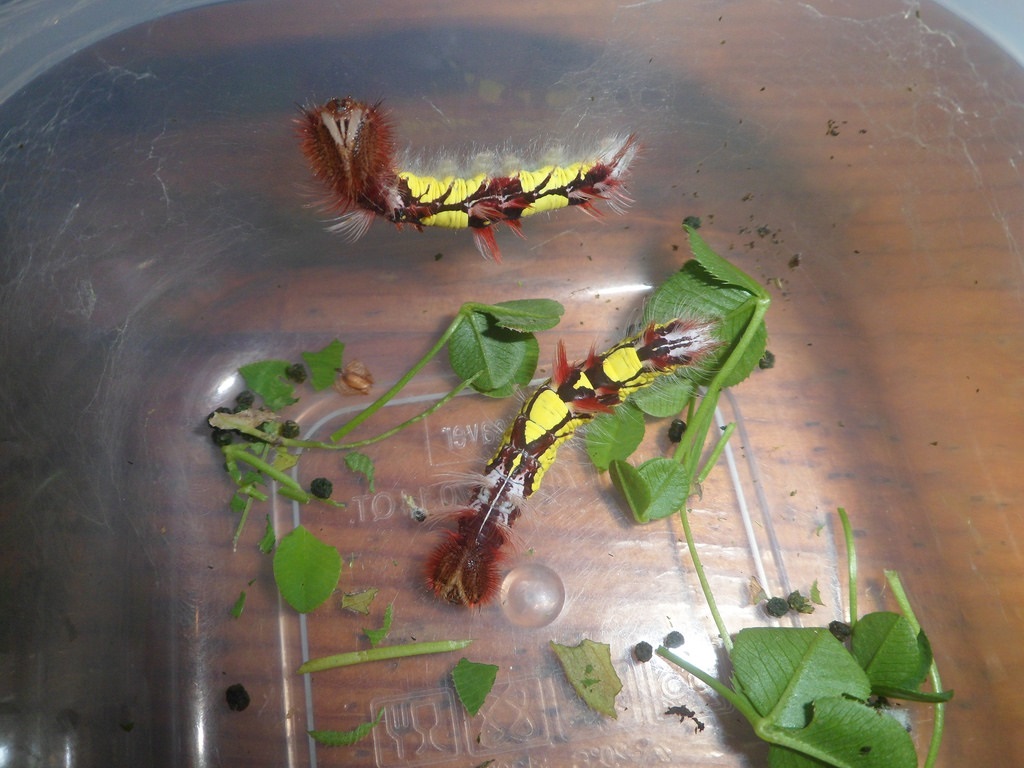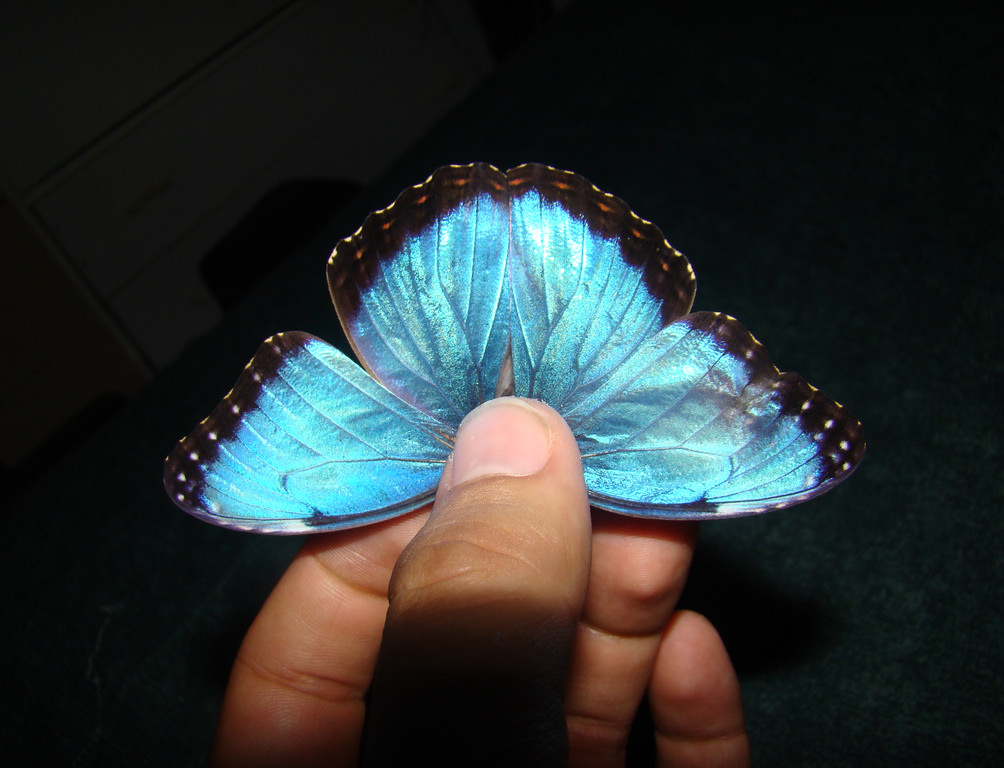Morpho peleides, also by default known as the “Blue Morpho” or in some cases Peleides Blue Morpho, as they are a lot of different Morpho species of which most also appear blue – is an iridiscent blue butterfly that is found in South America and Central America.
Mirror, mirror on the wall, who is the bluest of them all?
- Difficulty rating: Moderate (Easy for a butterfly but needs more effort than moths)
- Rearing difficulty: 6/10 (From egg to pupa)
- Pairing difficulty: 6/10 (Archieving copulations)
- Host plants: Eats Fabaceae such as Wisteria, Arachnis, Trifolium, Muccuna, Cassia. Larvae will feed on a wider range of Fabaceae than adults are willing to oviposit on
- Natural range: Central and South America
- Polyphagous: Yes but probably mainlyon Fabaceae
- Generations: Multivoltine (continuous breeding)
- Family: Nymphalidae (brush footed butterflies)
- Pupation: Chrysalis
- Prefered climate: Tropical – hot and humid
- Special notes: This species is being farmed commercially on a large scale – pupae are high in demand because it is one of the most popular species in tropical butterfly houses
Interesting about these insects is that they do not utilise blue pigment in order to archieve their blue colour. Instead, the scales absorb every colour except blue, which is reflected. The structure of the wing scales is responsible for this – their structure doesn’t allow light with the wavelength of blue to pass. In fact, it would be correct to state that this butterfly is technically not blue despite it’s appearance.
The underside of the wings is rather brown and decorated with ocelli (=eyespots) meant to ward off potential predators. With their wings closed they are quite inconspicuous.
This butterfly does not visit flowers and consume nectar. Instead, the Blue Morpho consumes fruit juice from fallen rotten fruits which are common in the forests they live, aswell as various other juices that are rich in sugar or minerals (tree sap, mineral deposits and sometimes even juices from feces or animal carcasses)
They feed on a very wide range of Leguminosae (pea family). In captivity, Trifolium sp. (clover), Wisteria (wisteria), Mucuna (velvet bean), Medicago sativa (alfalfa), Robinia (black locust), Arachis (peanut plant) are commonly used to rear them.
Morpho caterpillars are quite peculiar creatures
The caterpillars have a yellow body and some parts are covered in red hairs. They will grow quite large (about 9cm) over time and in their final instar assume a rather rusty brown/red colour. Shortly before pupating however, they will turn bright green. The pupae also have this green colour, and are well-camouflaged on foliage, resembling some kind of berry or fruit.
You’d have a hard time spotting these in nature, hidden between the green leaves
A beautiful small male of Morpho peleides, almost dwarf sized, from my rearings
Thank you for reading my article. This is the end of this page. Below you will find some useful links to help you navigate my website better or help you find more information that you need about moths and butterflies.
Dear reader – thank you very much for visiting! Your readership is much appreciated. Are you perhaps…. (see below)
-
-
- Not done browsing yet? Then click here to return to the homepage (HOMEPAGE)
- Looking for a specific species? Then click here to see the full species list (FULL SPECIES LIST)
- Looking for general (breeding)guides and information? Then click here to see the general information (GENERAL INFORMATION)
- Interested in a certain family? Then click here to see all featured Lepidoptera families (FAMILIES)
-
Citations: Coppens, B. (2019); Written by Bart Coppens; based on a real life breeding experience [for citations in literature and publications]
Was this information helpful to you? Then please consider contributing here (more information) to keep this information free and support the future of this website. This website is completely free to use, and crowdfunded. Contributions can be made via paypal, patreon, and several other ways.
All the funds I raise online will be invested in the website; in the form of new caresheets, but also rewriting and updating the old caresheets (some are scheduled to be rewritten), my educational websites, Youtube, breeding projects, the study of moths and conservation programs.
Donate button (Liberapay; credit card and VISA accepted)
Donate button (PayPal)
![]()
Become a member of my Patreon (Patreon)
![]()
Find me on YouTube

Find me on Instagram
![]()
Join the Discord server: Click here
Join the Whatsapp server: Click here
Buy insect cocoons: Click here
Facebook: Click here



Do you have anymore information concerning the morpho peleides ” blue morpho ” ?
LikeLike
I want to make my own collage of morpho butterflies under a large glass dome. Do you know where I can get the insects for this project? And a large oval glass do Everything?
LikeLike
thanks for the post. do you know if its possible to know if a caterpillar is male or female? best, Daniel
LikeLike
Hi – I’ve had some Morphos lay eggs in my butterfly exhibit. We are going to try to raise them behind the scenes. You mention Wisteria as a possible host plant and I have access to Wisteria frutescens (the native species). Have you ever tried to raise them on this? 2 of the 9 larvae have eaten and are growing a bit but the other 7 don’t seem interested. I was just curious what to expect and whether I should be trying to find fresh clover instead.
Thank you!
LikeLike
Is this good for butterdly beginners if not than what is
LikeLike
do they also feed on Clitoria ternatea
LikeLike
Is there a way to get Morpho peleides to lay eggs when your using a host plant it would refuse to lay its eggs on.
LikeLike
I raise butterflies annually as a hobby like yourself! I love all things nature. Can I get with you to buy directly if you are close enough?
LikeLike